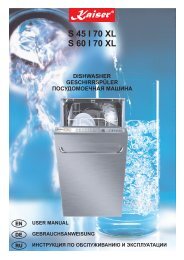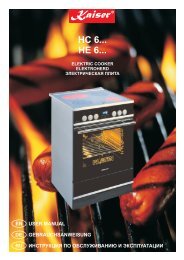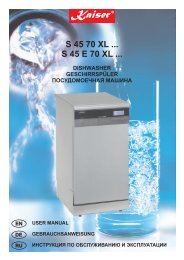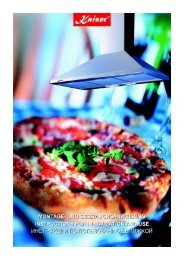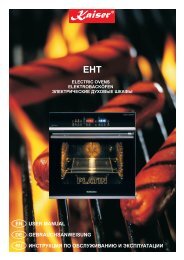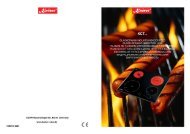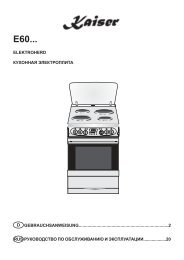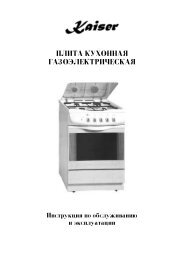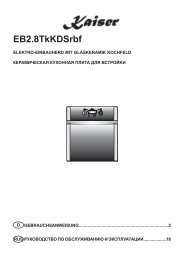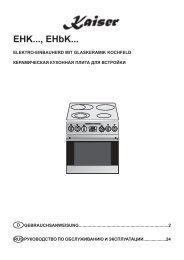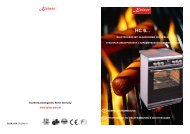KCT 6706 FI - Фирменный интернет-магазин бытовой техники ...
KCT 6706 FI - Фирменный интернет-магазин бытовой техники ...
KCT 6706 FI - Фирменный интернет-магазин бытовой техники ...
You also want an ePaper? Increase the reach of your titles
YUMPU automatically turns print PDFs into web optimized ePapers that Google loves.
Instructions for assembly<br />
Instructions for assembly<br />
Safety instructions for the kitchen fitter<br />
• Veneers, stuck-on or plastic surfaces of surrounding furniture must<br />
be temperature resistant (>75°C). If the veneers and surfaces are<br />
not sufficiently heat resistant they can become deformed.<br />
• Ensure that all live connections are safely insulated when installing<br />
the hob.<br />
• Cover strips between the wall and the worktop behind the hob<br />
which are made of solid wood are permissible as long as minimum<br />
clearances in accordance with the installation diagrams are<br />
maintained.<br />
• Minimum clearances of the hob cut-out towards the rear are to be<br />
maintained in accordance with the installation diagram.<br />
• For installation directly next to a tall cupboard, a safety distance of<br />
at least 40 mm. The side surface of the tall cupboard should be fitted<br />
with heat resistant material. Due to working requirements,<br />
however, the distance should be at least 300 mm.<br />
• The clearance between the hob and an extraction hood must be at<br />
least as large as that stipulated in the assembly instructions for the<br />
cooker hood.<br />
• The packaging materials (plastic foil, polystyrene, nails etc.) must<br />
be kept out of reach of children as these parts are potentially dangerous.<br />
Small parts can be swallowed and there is a danger of suffocation.<br />
Installation<br />
Important<br />
• If the cooking surface is located above furniture parts (side panels,<br />
drawers, etc.), then an intermediate bottom must be inserted at a<br />
minimum distance of 20 mm in order to prevent accidental contact<br />
with the underside of the cooking surface. The intermediary shelf<br />
may only be removed by tools.<br />
• To avoid danger of fire, make sure that no combustible objects<br />
which could easily catch fire or become deformed on exposure to<br />
heat are directly next to or above the surface.<br />
Sealing of cooking zone<br />
Before installation, correctly insert the sealing unit delivered with the<br />
hob.<br />
• In addition, make sure that no liquids can penetrate between the<br />
edge of the hob and the worktop or between the hob and the wall<br />
and come into contact with any electrical appliances.<br />
• When installing a hob into an uneven worktop, e.g. with a ceramic<br />
or similar covering (tiles etc.), the seal on the hob is to be removed<br />
and the seal between the hob and worktop made with plastic<br />
sealing materials (putty).<br />
• The hob must under no circumstances be sealed with silicone<br />
sealant!This would make it impossible to remove the hob at a later<br />
date without damaging it.<br />
Ventilation<br />
• The back wall of the cabinet must be open in the area of the cut-out<br />
in order to provide for air circulation.<br />
• The front transverse strip of the furniture must be removed so that<br />
an opening is provided for air flow underneath the worktop over the<br />
entire width of the unit.<br />
• Remove any transverse strips underneath the worktop at least in<br />
the area of the worktop cut-out.<br />
• The distance between induction hob and kitchen furniture resp.<br />
built-in unit must provide for sufficient ventilation of the induction.<br />
• The ventilation openings must be thermically devided with the<br />
attached screen shield. Thus a back-flow of warmed air is prevented<br />
from entering the cool air intake.<br />
• Attention!<br />
The screen shield must not cover the ventilation openings. If<br />
necessary, shorten the shield up to the furniture or built-in unit.<br />
• Avoid excessive thermal development from below e.g. from a<br />
baking oven without a cross flow cooling device.<br />
• The induction hob may not be used when pyrolysis operation is<br />
taking place in a built-in oven.<br />
Bottom of the hob<br />
Front<br />
Insulation<br />
Insulation<br />
21



